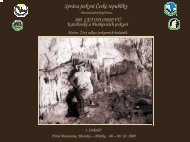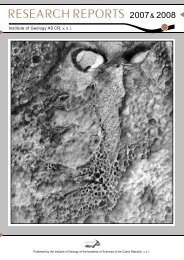triradiate locomotion Triadobatrachus evidenced segmentation
Get PDF (915K) - Wiley Online Library
Get PDF (915K) - Wiley Online Library
Create successful ePaper yourself
Turn your PDF publications into a flip-book with our unique Google optimized e-Paper software.
30 Development of the pelvic skeleton in frogs, H. RoCková and Z. RoCek<br />
Fig. 8 (A) Resconstruction of the pelvis in the early amphibian Ichthyostega from the Middle/Late Devonian in left lateral view<br />
(from Jarvik, 1996). (B) Left ilium of the pro-anuran Czatkobatrachus from the Early Triassic in presumably original position; left<br />
lateral view; scale bar, 1 mm (from Evans & Borsuk-Bialynicka, 1998). (C) Left ilium of the modern anuran Rana with indication<br />
of muscle origins; left lateral view (from Gaupp, 1896). (D) Pelvis of the pro-anuran <strong>Triadobatrachus</strong> massinoti from the Early<br />
Triassic in ventral view. Both ilia are disarticulated and exposed in lateral aspect. Note presence of free sacral and first postsacral<br />
ribs; scale bar, 5 mm (from Rage & RoCek, 1989). (E) Superficial thigh muscles in the neotenous tailed amphibian Ambystoma in<br />
dorsolateral view. (F) Superficial thigh muscles of Rana in dorsal view (from Gaupp, 1896). Note similar muscle patterns in E and<br />
F, although orientation of the iliac shaft is markedly different.<br />
M. iliofibularis remained a flexor of the knee joint<br />
(acting similarly to the sartorius on the ventral side of the<br />
thigh), thus not belonging among those muscles responsible<br />
for jumping. M. iliofemoralis, originating together<br />
with m. iliofibularis, is a thin muscle acting parallel with<br />
iliacus internus, i.e. as the flexor of the thigh.<br />
Apparently the original thigh muscle pattern of the<br />
temnospondyls was a satisfactory prerequisite for later<br />
saltation and swimming of the anurans (even burrowing<br />
did not affect the proximal hind-limb muscles,<br />
although it causes a decrease in jumping ability; Emerson,<br />
1976). In frogs, both types of <strong>locomotion</strong> and all types<br />
of functional patterns of the thigh and ilio-sacral musculatures<br />
are largely the same (Emerson & De Jongh,<br />
1980), although it seems that swimming by ‘jumping’<br />
movements was acquired only secondarily – there<br />
would not be a need to change the anatomical pattern<br />
associated with swimming by means of lateral body<br />
undulations if there was not an intermediate terrestrial<br />
stage between the temnospondyls and anurans. In this<br />
context, the posterior rotation and elongation of the<br />
iliac shaft was an evolutionary process (compare in<br />
Fig. 8A, 8B and 8C) that was not accompanied by profound<br />
changes in the thigh musculature pattern. Besides,<br />
the fact that in frogs the tuber superius became an<br />
insertion area exclusively for flexors suggests that the<br />
tuber is not associated with jumping as is sometimes<br />
believed. It may rather be a vestigial iliac process that<br />
was developed for insertion of iliocaudal muscles in<br />
swimming tailed amphibians. This would also explain<br />
the considerable size of the tuber superius in proanuran<br />
<strong>Triadobatrachus</strong> and Czatkobatrachus (Rage & RoCek,<br />
1989; Evans & Borsuk-Bialynicka, 1998; Fig. 8B), although<br />
they were still not capable of jumping, and its comparatively<br />
small size in the earliest frog Prosalirus (Jenkins<br />
& Shubin, 1998) and in good jumpers such as Rana.<br />
© Anatomical Society of Great Britain and Ireland 2005





